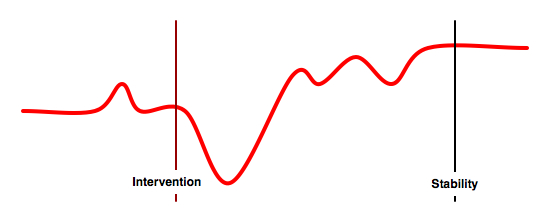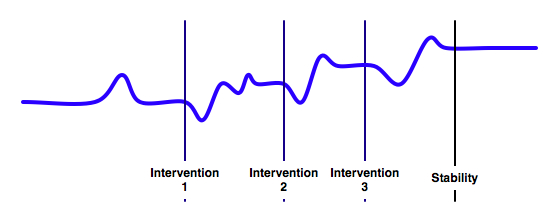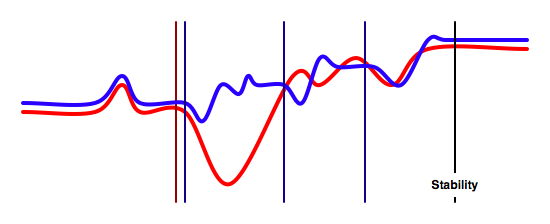A tweet by @JoshuaKerievsky pointed me to the Satir Change Model, in the context of introducing agile programming. The model purports to capture the disruptive effects of a new idea until it’s internalized, and I find it resonates quite well. My simplified version looks at it from the point of view of organizational change upon introduction of a new initiative, such as the organizational learning transformations I’m espousing and supporting.

In this simplified version, you can see that an intervention originally creates a decrement in performance, until the intervention takes hold, and then there are some hiccups incurred until the system stabilizes at a new and (hopefully) improved performance outcome. While we want the improvement, the decrement is something we’d like to minimize. However, how do we do that?
In researching it a little bit, I came upon a book that discussed using a stepwise approach to minimize it (also in software process improvements), and had a version of the diagram that demonstrated smaller decrements. By having smaller introductions that break up the intervention, you decrease the negative effects. The point is to take small steps that make improvements instead of a monolithic change.
By having smaller introductions that break up the intervention, you decrease the negative effects. The point is to take small steps that make improvements instead of a monolithic change.
That’s what I’m trying to achieve is breaking up the organizational transformation implied by the performance ecosystem, and customizing it for an organization by prioritizing steps into next week, next month, next year, etc. Of course, the diagram is only indicative, not prescriptive, but I trust you recognize what I mean.
The overall approach is to achieve the improvement, but in a staged way customized for a particular organization and context, not a one-size-fits-all approach that really won’t fit anyone. The goal is to maximize improvements while minimizing disruption, and doing so in ways that capitalize on previous efforts and existing infrastructure. To do this really requires understanding how the different components relate: how content models support mobile, how performance support articulates with formal learning and social media, and more. And, of course, understanding the nuances of the underpinning elements and how they are optimized.
The goal is to maximize improvements while minimizing disruption, and doing so in ways that capitalize on previous efforts and existing infrastructure. To do this really requires understanding how the different components relate: how content models support mobile, how performance support articulates with formal learning and social media, and more. And, of course, understanding the nuances of the underpinning elements and how they are optimized.
Organizations can’t continue in the status quo of only formal learning, but I reckon many folks aren’t sure where and how to start. That’s the point of using a framework that points out how the elements interact, and coupling that with an specific organizational assessment. From there, you can prioritize steps, come up with action plans, be prepared to choose vendors, not have the vendor sell you on what they do best, and more. You’ve got to have a plan, or where you end up may not be the best place for your organization.
I’m reminded of the Cheshire Cat and Alice:
“Would you tell me, please, which way I ought to go from here?”
“That depends a good deal on where you want to get to,” said the Cat.
“I don’t much care where–” said Alice.
“Then it doesn’t matter which way you go,” said the Cat. ”
–so long as I get SOMEWHERE,” Alice added as an explanation.
“Oh, you’re sure to do that,” said the Cat, “if you only walk long enough.”
So, do have a plan of where you want to get to, as well as an intent to start moving?
Clark,
I’m reminded of an image I used years ago, based on work we did with Barry Raybould (back in the performance support hey day with Gloria Gery). Barry had a slide similar to your graphics that we used to get people to stop viewing learning as a one time event (intervention 1), but rather an ongoing effort. The interventions were a means to scaffold the learning over time, rather than expect people to come out of a class knowing it all. We continued to evolve the slide to demonstrate change management concepts, the need for performance support, as well as push for manager involvement pre- and post- training.
Nice to know there is some formal work being done around the concepts, and that other tools may emerge. I’ll have to examine the Satir site and book more closely.
As an aside, you and I seem to think very much alike. I was planning to dust off my old slide for an upcoming presentation I’m doing. I had also been planning to use the Alice quote when discussing the need for a documented learning strategy (the lack of which is one of top 5 mistakes). (I like using Wonderland as a metaphor – hence the origins of my site. Need to build it out more, though.)
Thanks, again, for the great thoughts and useful references.